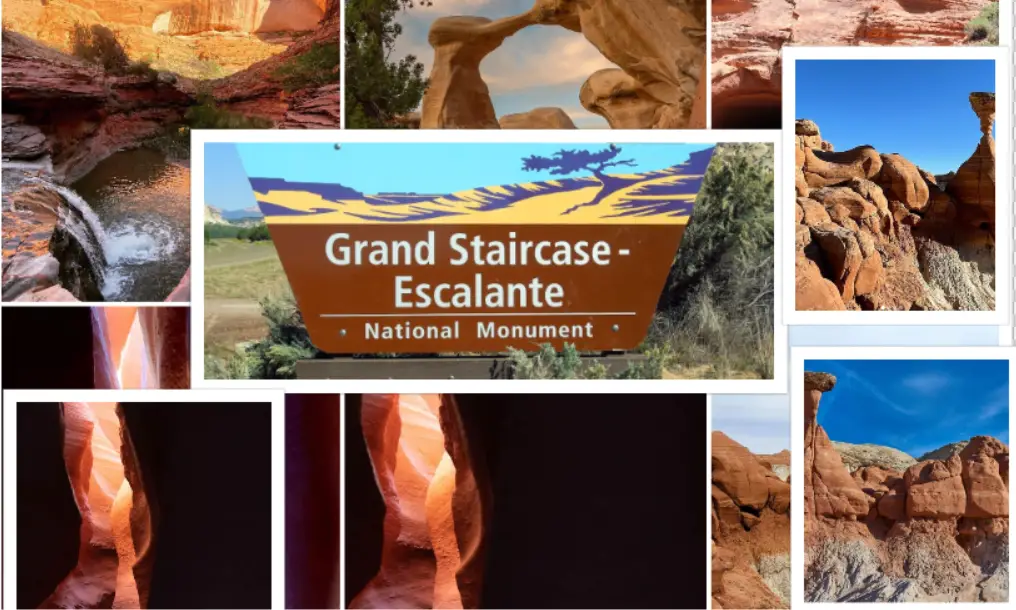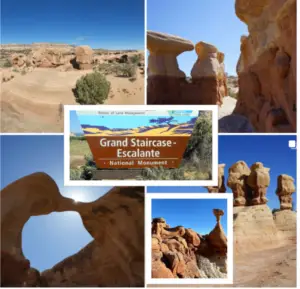Grand Staircase–Escalante National Monument : Interesting Facts, History & Travel Guide

- By
- Aparna Patel
- |
- 1 Apr, 2023
- |

Grand Staircase–Escalante National Monument is a vast and remote wilderness area located in southern Utah, USA. This stunning monument covers 1.9 million acres and is home to unique geological and cultural features that attract visitors from around the world.
In this blog, we will explore the interesting history, facts, and travel guide of Grand Staircase–Escalante National Monument, including some of the best hiking trails, camping spots, and other activities to enjoy in this spectacular natural wonder. Whether you’re an experienced hiker or just looking to escape the hustle and bustle of city life, Grand Staircase–Escalante National Monument is the perfect destination for anyone seeking adventure and solitude in the great outdoors.
Table of Contents
Interesting facts about Grand Staircase–Escalante National Monument
- Grand Staircase–Escalante National Monument is located in southern Utah, USA and covers an area of 1.9 million acres.
- It was designated as a national monument in 1996 by President Bill Clinton, making it one of the newest national monuments in the United States.
- The monument is named after two prominent geological features: the Grand Staircase and the Escalante River.
- The Grand Staircase is a series of colorful cliffs that step up from the Grand Canyon in Arizona to Bryce Canyon National Park in Utah, while the Escalante River is a tributary of the Colorado River that runs through the monument.
- The monument is home to a wide variety of flora and fauna, including 46 species of mammals, 262 species of birds, and 67 species of reptiles and amphibians.
- It is also known for its unique geologic formations, such as slot canyons, natural arches, and hoodoos (tall, thin spires of rock).
- The monument has a rich cultural history, with evidence of human habitation dating back over 10,000 years. The area was home to several Native American tribes, including the Ancestral Puebloans, the Fremont, and the Southern Paiute.
- The monument also contains important historical sites from the late 19th and early 20th centuries, such as old mining towns and cattle ranches.
- Visitors to the monument can enjoy a variety of outdoor activities, such as hiking, camping, fishing, and horseback riding. There are also several scenic drives and overlooks that offer stunning views of the surrounding landscape.
Information & History of Grand Staircase–Escalante National Monument
The Grand Staircase is a series of colorful cliffs that step up from the Grand Canyon in Arizona to Bryce Canyon National Park in Utah. The cliffs are made up of several distinct layers of rock, each representing a different period of geologic time. The Escalante River is a tributary of the Colorado River that runs through the monument, cutting deep canyons and forming natural arches and bridges.
The area that is now Grand Staircase–Escalante National Monument has a rich cultural history, with evidence of human habitation dating back over 10,000 years. The monument was home to several Native American tribes, including the Ancestral Puebloans, the Fremont, and the Southern Paiute. The monument also contains important historical sites from the late 19th and early 20th centuries, such as old mining towns and cattle ranches.
Grand Staircase–Escalante National Monument was designated as a national monument in 1996 by President Bill Clinton, making it one of the newest national monuments in the United States. The designation was controversial, with some local residents and politicians opposed to the creation of the monument. However, supporters argued that the area’s unique geologic and cultural features deserved protection.
Visitors to Grand Staircase–Escalante National Monument can enjoy a wide variety of outdoor activities, including hiking, camping, fishing, and horseback riding. There are several scenic drives and overlooks that offer stunning views of the surrounding landscape. The monument is also home to a diverse array of wildlife, including several species of mammals, birds, and reptiles.
Read More:
- Grand Portage National Monument : Interesting Facts, History & Travel Guide
- Grand Canyon–Parashant National Monument : Interesting Facts, History & Travel Guide
- Governors Island National Monument : Interesting Facts, History & Travel Guide
- Gold Butte National Monument : Interesting Facts, History & Travel Guide
- Gila Cliff Dwellings National Monument : Interesting Facts, History & Travel Guide
- Giant Sequoia National Monument : Interesting Facts, History & Travel Guide
Travel Guide for Grand Staircase–Escalante National Monument
When to go: The best time to visit the monument is from spring through fall (March to November), when the weather is mild and dry. Summer can be hot, so plan to hike in the early morning or late afternoon. Winter months can be harsh, with snow and freezing temperatures, but the landscape can be stunningly beautiful.
Getting there: The monument is located in a remote area of southern Utah and is not easily accessible by public transportation. The closest airports are in Salt Lake City and Las Vegas, both about a five-hour drive from the monument. The nearest town with services is Escalante, which is located on the eastern side of the monument.
Things to do: There are many outdoor activities to enjoy in Grand Staircase–Escalante National Monument. Some of the most popular activities include hiking, camping, fishing, and horseback riding. The monument is also a great place for photography and stargazing.
Some of the most popular hiking trails include:
- Lower Calf Creek Falls: a 6-mile round-trip hike that leads to a beautiful waterfall and swimming hole.
- Zebra Slot Canyon: a 5-mile round-trip hike that takes you through a narrow, twisting canyon with striped walls.
- Devil’s Garden: a 1-mile loop hike that takes you through a surreal landscape of sandstone arches and hoodoos.
Where to stay: There are several campgrounds within the monument, including the popular Devil’s Garden Campground and the Calf Creek Campground. Both offer basic amenities such as picnic tables, fire rings, and vault toilets. There are also several primitive camping areas throughout the monument, but be sure to follow Leave No Trace principles and obtain any necessary permits.
For those who prefer more comfortable accommodations, there are several lodges and hotels in the nearby towns of Escalante, Boulder, and Kanab.
What to bring: Be sure to bring plenty of water, sunscreen, and insect repellent. The desert can be unforgiving, so it is important to be prepared for the elements. Comfortable hiking shoes and appropriate clothing are also essential.
Overall, Grand Staircase–Escalante National Monument is a stunning and unique wilderness area that is well worth a visit for anyone who loves the great outdoors. Be sure to plan ahead, bring plenty of water and supplies, and be respectful of the fragile ecosystem.
More Articles:
- George Washington Carver National Monument : Interesting Facts, History & Travel Guide
- Freedom Riders National Monument : Interesting Facts, History & Travel Guide
- Fossil Butte National Monument : Interesting Facts, History & Travel Guide
- Fort Union National Monument : Interesting Facts, History & Travel Guide
- Fort Stanwix National Monument : Interesting Facts, History & Travel Guide
- Fort Matanzas National Monument : Interesting Facts, History & Travel Guide
- Florissant Fossil Beds National Monument : Interesting Facts, History & Travel Guide
- Fort Frederica National Monument : Interesting Facts, History & Travel Guide
FAQ about Grand Staircase–Escalante National Monument
What is the Grand Staircase?
The Grand Staircase is a series of cliffs that step up from the Grand Canyon in Arizona to Bryce Canyon National Park in Utah. The cliffs are made up of several distinct layers of rock, each representing a different period of geologic time.
What is the Escalante River?
The Escalante River is a tributary of the Colorado River that runs through Grand Staircase–Escalante National Monument, cutting deep canyons and forming natural arches and bridges.
When was Grand Staircase–Escalante National Monument created?
The monument was designated in 1996 by President Bill Clinton, making it one of the newest national monuments in the United States.
What are some popular hiking trails in the monument?
Some of the most popular hiking trails include Lower Calf Creek Falls, Zebra Slot Canyon, and Devil’s Garden.
Can you camp in the monument?
Yes, there are several campgrounds within the monument, including Devil’s Garden Campground and Calf Creek Campground. There are also primitive camping areas throughout the monument.
What is the nearest town with services?
Escalante is the nearest town with services, located on the eastern side of the monument.
What is the best time to visit Grand Staircase–Escalante National Monument?
The best time to visit is from spring through fall (March to November), when the weather is mild and dry. Summer can be hot, so plan to hike in the early morning or late afternoon.
What should I bring with me to the monument?
Be sure to bring plenty of water, sunscreen, insect repellent, comfortable hiking shoes, and appropriate clothing. The desert can be unforgiving, so it is important to be prepared for the elements.
What activities can I do in the monument besides hiking?
Other popular activities include camping, fishing, horseback riding, photography, and stargazing.
Search Posts
Latest posts
-
4 Mar, 2024
How can I do a "broad" search for flights?
Popular posts
-
5 Mar, 2024
Why prohibit engine braking?
